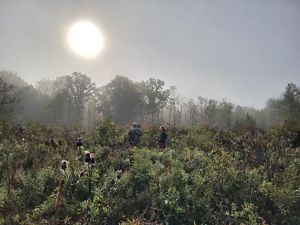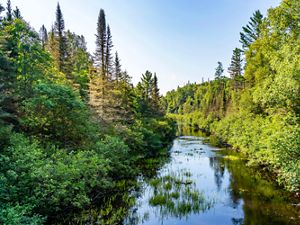The Nature Conservancy Planting 40,000 Trees in Ottawa National Forest This Week
Mix of native trees will be planted in area impacted by spruce budworm to protect native brook trout.
Media Contacts
-
Ryan Hermes
TNC
Phone: 517-999-7745
Email: ryan.hermes@tnc.org
The Nature Conservancy in Michigan (TNC), in partnership with the Ottawa National Forest, today announced crews will begin planting 40,000 trees across 131 acres in the Paint River Watershed this week. The goal of the project is to underplant conifers near cold and cool water streams, replacing trees impacted by spruce budworm to protect the region's renowned cold-water trout fisheries.
“In three years, these trees will be big enough to start providing cover for small animals and shade to the river,” said Michael Crump, interim forest supervisor of the Ottawa National Forest. “The partnership with The Nature Conservancy in Michigan provides the expertise to deliver nature-based solutions to natural resource problems.”
Quote: Michael Crump
The partnership with The Nature Conservancy in Michigan provides the expertise to deliver nature-based solutions to natural resource problems.
Spruce budworm is a native pest that defoliates the spruce and fir trees along streams resulting in the daylighting of streams. Daylighting of streams harms native brook trout by increasing stream temperatures and degrading critical cold-water streams. The project, long-term, will create a canopy over the river which will help keep the temperatures down and aid in healthy fish habitats. It also diversifies forest cover near streams needed for both aquatic and terrestrial wildlife and protects water quality by stabilizing stream banks to reduce erosion potential.
“Our forests are vital for both people and nature by serving as a habitat to wildlife, filtering our water, moderating our climate, and providing the canopy for countless outdoor adventures,” said Mindy Kantola, forest partnerships project manager at TNC in Michigan. “We’re proud to partner with the Ottawa National Forest on this ongoing effort because climate resilient lands and waters benefits us all.”
Quote: Mindy Kantola
We’re proud to partner with the Ottawa National Forest on this ongoing effort because climate resilient lands and waters benefits us all.
Through the partnership, TNC has identified and prioritized planting areas. Project implementation is now underway with the underplanting of a mix of white pine, red pine, white spruce, tamarack, hemlock, and cedar trees with the help of Timberland Forestry Services, a contractor based in Munising, MI.
TNC is providing the logistics to deliver trees to staging points near the planting site and to mark the areas where the planting should occur. The trees will be planted in riparian areas that connect the watershed to streams and upland areas. It is expected to take a crew of seven people one week to plant the trees by hand.
The saplings will replace spruce and balsam trees damaged by spruce budworm. The budworm damages trees by eating their foliage and creating large gaps in the canopy. This damage reduces the growth of trees under the best circumstances but will kill large groups of trees under the worst.
“We appreciate projects like this, which provide streams, rivers and riparian areas the ingredients they need for natural process-based restoration,” said Ottawa National Forest Fisheries Biologist Ryan Beatty. “Planting efforts like this are long-term investments in stream shade, protection of cold-water trout habitat, and long-term recruitment of fallen trees important to fish habitat.”
Quote: Ryan Beatty
We appreciate projects like this, which provide streams, rivers and riparian areas the ingredients they need for natural process-based restoration.
TNC has a long track record of partnering with the U.S. Forest Service, including over 1,200 acres of riparian tree planting efforts, stewardship timber harvests, and recreational and wilderness area trail maintenance and boardwalk construction in the Ottawa National Forest.
Just over half of Michigan—or 20 million acres—is forested and represents a vital part of Michigan’s nature. Our forests provide a home to iconic wildlife like the gray wolf, black bear and migratory songbirds that fill the trees with color in the spring. They are also an important legacy for people, supporting more than 100,000 jobs and a $20 billion economy.
The Nature Conservancy is a global conservation organization dedicated to conserving the lands and waters on which all life depends. Guided by science, we create innovative, on-the-ground solutions to our world’s toughest challenges so that nature and people can thrive together. We are tackling climate change, conserving lands, waters and oceans at an unprecedented scale, providing food and water sustainably and helping make cities more sustainable. The Nature Conservancy is working to make a lasting difference around the world in 81 countries and territories (40 by direct conservation impact and 41 through partners) through a collaborative approach that engages local communities, governments, the private sector, and other partners. To learn more, visit nature.org or follow @nature_press on X.


